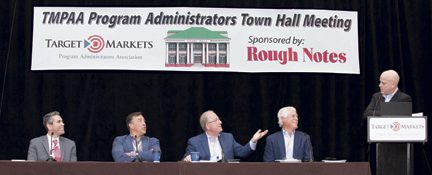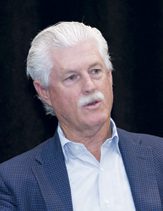2019 TMPAA TOWN HALL
What is driving “hysteria” in the M&A market?
By Dave Willis, CPIA
Merger and acquisition activity in the insurance market is strong. How strong? Strong enough that Mystic Capital Managing Director Kevin Donoghue used the word “hysteria” to frame the activity as he moderated a town hall panel presentation at this year’s Target Markets Program Administrators Association mid-year meeting in Baltimore. “Acquisitions are at a fever pitch,” he added, “and the majority are on the distribution side.” Serving as panelists were representatives from three of the top acquirers—Assured Partners at number three, Brown & Brown (and its Arrowhead unit) at 10, and Ryan Specialty Group at 14.

To start the session, panelists shared thoughts on the influence that ownership type has—or doesn’t have—on deals. Tom Riley, president and COO of private equity-backed Assured Partners, said ownership levels at his firm were similar to levels for employees at public or privately held brokers. Tony Campisi, president and CEO of Glatfelter Insurance Group, said his firm’s focus remains the same through recent ownership changes: “Our focus as an acquirer, particularly in the program space, was always strategic in nature—not to be an aggregator, but to find programs in sectors where we already operated. We don’t see that changing.”
Steve Boyd, president and COO of Arrowhead Group, a division of Brown & Brown, said, “For us, being public lets us offer ownership to pretty much anybody within the firm. That was a problem before.” Miles Wuller, COO of privately held Ryan Specialty Group Underwriting Managers, added: “Being privately held offers distinct advantages: We’re able to take a longer term view of every acquisition.”
He added, “Many deals start with a cultural focus, where we’re looking for top talent and distinct products that aren’t competing with Main Street, where we can take the time to continue to invest and get it right. A big part of our competitive advantage has been finding the right levers to take a company to the next plateau, whether that’s distribution, products, or infrastructure.”

-Tony Campisi
President and CEO
Glatfelter Insurance Group
Identifying quality
Campisi shared non-financial metrics that he thought defined quality firms. “First and foremost,” he said, “is the market niche itself, and how well it aligns with what we do and how we can add value.” Talent pool also is important. “A book of business has its own value,” he added, “but we all know what holds it in place, and that’s its people.” The technology platform, data ownership, and data analysis round out the top metrics.
“The cultural fit is a big deal,” Boyd noted. “We’re an underwriting platform first, and distribution and sales technology come with that. But at the end of the day, reputation means everything. When I look at a prospect, it’s people first: Is there an underwriting culture? Is leadership strong, and how’s the depth under that? Where can we add value? It’s not just one plus one equals two; it’s beyond that.”
Asked about potential deal-killers, Wuller brought up the underwriting history of an acquisition and the firm’s experience with its carrier panel. “Part of sustainability is making sure [the company being acquired] has had a great relationship with its supporters and that it hasn’t been churning markets rapidly,” he explained.
Panelists then shared insights on the courtship process. “I’ve been doing this for 25 years, and I’ve found that the most successful acquisitions come from relationships that I or members of our team have built with potential sellers,” Boyd explained. “Over the years, we’ve all been down that same road together. Through those relationships, our due diligence process is typically a couple of weeks.
“We’re in the space in a big way,” he added, “so we know pretty much every trading partner out there. In many cases we know about the programs before we even talk to the people. We know the results, and we can cut to the chase pretty quickly and get a sense for where the trajectory is.”
Campisi echoed the value of knowing potential partners. “Relationships really do matter,” he said. “Any time you’re looking at an acquisition opportunity I think there is an inverse correlation: the stronger that relationship, the less time you’re going to need to get through a due diligence process. You already have a strong relationship in place, and that will raise the trust factor and facilitate a much quicker due diligence process.
“That said, though, when we look at an acquisition, we want to know that its leadership has every expectation that the deal will succeed,” he added. “We’re doing due diligence for a reason: We want to make sure that expectations are clear on both sides.” His firm operates in a 60- to 90-day time frame for due diligence.
Riley, whose firm can have a number of acquisitions in process at any given time, described the teams working on due diligence, contracts, human resources, and accounting, and then offered insight into one more piece of the puzzle: “We have an integration team that will arrive shortly after the acquisition is completed to help our new agency people with anything they need.”

-Tom Riley
President and COO
AssuredPartners
Challenges faced
“Some of our toughest war stories are about underestimating the amount of effort required to remediate poor underwriting practices,” Wuller said. Among prospective candidates, “you’re going to come across ones where you think you can make the tweaks and they’ll do better with a little more supervision. But inevitably, turning around underwriting takes longer than you would hope.”
“Before we were acquired and didn’t have as much money to make acquisitions, we would do organic startups or small acquisitions,” Boyd recalled. “I think back to some horror stories we had; it was where the market was supposedly in tow.
“As the acquired firm came on board, we found that the relationship was not nearly as stable as we thought, that the loss trends were not as good as we thought, and that there was no real remediation,” he added. “So for me it comes down to the underwriting discipline, the culture, and the relationship with the market; that’s always the center of that conversation.”
“As we look at the world of insurance, we tend to talk about the insurance marketplace, but that marketplace is made up of an enormous number of sub-markets,” Campisi observed. “You need to guard against thinking of this as ‘the market.’ We’ve learned that we can’t take the elements of one program and just replicate it in the next. Every one is unique, even in a similar underwriting segment. We have different competitive forces, different buyer perspectives, and different distribution channels.
“The climate is different from segment to segment,” he added, “and you have to adapt to that, and do it in a way where you’re making good fundamental underwriting and pricing decisions, and you’re looking at the business from a long-term perspective. It’s not just about how fast you can grow it, but how can you grow it in a sustainable way?
“Our founder was fond of saying, ‘If I don’t have an underwriting profit, I don’t have a program.’ It’s that simple,” Campisi said. “But it’s hard to keep that perspective when you’re trying to grow a program.” n
For more insight from the panel, including discussions on earnings multiples, payment methods, and where the M&A market is going, visit the Target Markets podcast at http://bit.ly/RNTHMergers, where the session can be replayed in its entirety.




